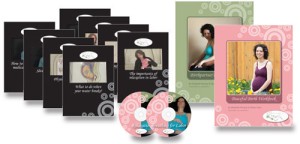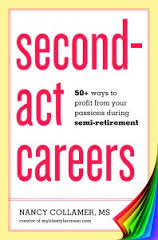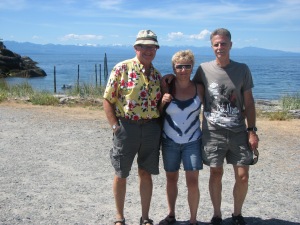Last week we shared some of the ideas that came up at a recent “Free at 55” Meetup around the subject of post-retirement careers: envisioning your lifestyle, knowing both your strengths and your requirements, consulting gigs, overseas teaching assignments, and volunteering. This week, we continue sharing our members’ ideas around 2nd-act careers, including some ideas that came up at previous evenings.
Take the travel blogger who also finances her overseas travel by doing the research for her children’s books set in foreign lands. Or the couple who organize small group African safari expeditions that cover the cost of their own participation.
One idea that garnered a fair amount of attention a our last evening was starting a business, especially a web business that could be managed from anywhere on the planet that has good Internet access.
As with other 2nd-act careers, lifestyle considerations are key. The trick is to create a business that can succeed with the level of effort you want to devote to it. Trading a 40-hour a week desk job for a non-stop commitment requiring more than 60 hours a week of your time may not be what you had in mind. As some of our members shared, it’s relatively easy to end up in this situation. A bit of reality check may help avoid forging new chains.
One piece of advice was to be sure to tailor services to an audience whose business needs complement your lifestyle needs. Serving a niche with more laid-back expectations may be the wisest course. Remember also that you don’t have to do everything well, even within that well-defined niche. As Tim Ferris and others have suggested, it’s never been easier to outsource the portion of the work that your not prepared to do.
As we heard last week, most 2nd-act careers build on past careers skills and successes in some way. Look for ways to use the skills you already have and benefit from what you already know. Last year one of our Meetup members, Elizabeth, told us about her experience as a “retiring” midwife. She spent many months putting together a polished set of videos on natural childbirth, as well as a workbook and relaxation audios. By outsourcing the technical work she created a web site to advertise and sell this educational package. Since launching, she has been able to bring in enough of an income to allow her to retire, and, as she wrote to me recently, is “now living in sunny Spain 6 months of the year, and loving it.” Since launching the original site, she has naturally branched out into the post-birth market with a second site: BellyToBabyCoupons.com.
Elizabeth’s experience underscored an important lesson that we also heard from others who started a business. Building a business is a different activity to working in a business. You need to enjoy the process of building and working on your business. In Elizabeth’s case, once she had her subject matter recorded in her video-and-workbook package, there wasn’t much “midwifery” left to do. What there was to do instead was finding new customers – the work of marketing her product. This meant searching out and acting on opportunities to interact with others in her marketplace, whether affiliates, referrals, or just communities of potential clients. She reported that the single biggest factor affecting her monthly income was how much marketing she was doing.
Despite the promise of books such as “The 4-Hour Workweek”, most of our members who tried this had found that it took a lot more than four hours a week, especially to get started. This is not the end of the world, if you are enjoying the time you put into it, and it still allows you the lifestyle you want. However, some found they’d traded a job they loved for a business full of jobs they hated. In this case, taking stock and a possible reset may be involved. Some of our participants were looking at their second or third attempt.
Still, many of us felt there was a lot of potential in a web-based business, whether it be local or international in scope. Maybe it’s creating events and happenings for your tribe. Or selling information products such as eBooks, downloadable manuals, videos and podcasts. There are no end of resources available to help you with this, and, while all of us had some ideas, none of us were experts in this area.
And yes, there truly is no end to the assistance that will be offered you if you mention that you’re thinking of starting a business, particularly an Internet-based business. Some of the offers will likely be fraudulent, and many more bordering on that. But even after eliminating all the questionable advice, you can still be overwhelmed by all the well-meaning and often quite useful coaches, blogs, sites and systems that offer you a path to business success. You’ll soon find that you’ll want to pick a few sources that work for you – perhaps they resonate with your background or aspirations – and ignore the remaining 99%.
Perhaps you’ll run into something that really speaks to you. Recently, I was looking into a program called “How to Start Software and SaaS Companies from Nothing” offered by “The Foundation”. While I didn’t sign up for their six-month program, I was still able to glean some valuable advice from their website marketing videos. In addition to offering some concrete examples of how much of starting an Internet business was about the marketing – in fact, the technical work itself was usually outsourced – they pointed to something very important for many of us looking to make something new happen in our lives. Starting a new career or business will require you to transcend your self-limiting beliefs about money, … or ability, … or any number of beliefs that get in the way of doing something creative, and becoming that 2nd-act butterfly.
Who knew “retirement” was going to be so much work?
It’s not all bad news, though. The act of taking on a new challenge of growth may be the very thing that keeps you young and healthy when the calendar suggests you should be losing your edge.
It may also be the opportunity to seek out new social networks as you look for support in making these changes. Finding them is not that hard. If nothing else, you can join one of the numerous Meetups devoted to new business success, Internet marketing, or other sorts of “dream building” such as our own “Free at 55” Meetup.
Perhaps you’re on the same path as we and other members of our Meetup. If so, you’ll:
- Have a detailed plan for your post-retirement life, captured in a compelling “vision document,” and including detailed budgeting of expected costs and investment income.
- Create an inventory of past experience and business skills, with emphasis on those you most enjoy using.
- Connect with others who can support you.
- Start trying things on.
- Have a plan, and be persistent.
Finally, don’t forget to enjoy the ride! Perhaps the most important lesson shared by everyone at the Meetup was that “retirement is not a destination – it’s a journey.” Your 2nd-act career may be just one of many “second” acts. It will almost certainly evolve over time.
So when you start “Dancing your 2nd-Act Career”, know that you’ll keep on dancing till the end…
“Dance me to the end of love, dance me to the end of love. Dance me to the end of love.” – Leonard Cohen
More Resources:
Here a few more resources that came up during our evening:
- “How to Pivot your Career” (scroll down to read)
- “The Pathfinder” by Nicholas Lore
- “The Age Advantage: making the most of your midlife career transition” by Jean Erickson Walker,
- “The Career Guide for Creative and Unconventional People” by Carol Eikleberry
- “The Great Work of Your Life” by Stephen Cope
- “The Art of the Start” by Guy Kawasaki
- “Living the 80/20 Way” by Richard Koch
- “The eMyth Revisited: why most small businesses don’t work and what to do about it” by Michael E. Gerber
- And there are more in Part I of this post.






























